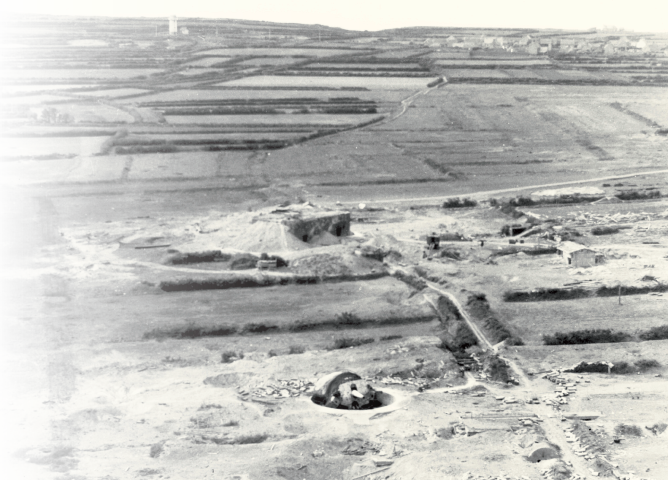The Graf Spee battery fire control post.
This bunker we are in is the Graf Spee naval artillery battery command post.
It consists of two standard bunker plans, connected by a tunnel. The lower level is a type M 151 bunker, which housed the garrison in charge of close-in defence. The four upper levels, S 414 type, were devoted to the control of the four 280 mm guns situated around 1500 metres away inland. In this part of the bunker were accommodation for the technicians, rooms for the ventilation system and generators and a signals centre. The targeting equipment was in the top sections: rangefinder, goniometer and parallax corrector.

The Graf Spee battery fire control post.
This bunker we are in is the Graf Spee naval artillery battery command post.
It consists of two standard bunker plans, connected by a tunnel. The lower level is a type M 151 bunker, which housed the garrison in charge of close-in defence. The four upper levels, S 414 type, were devoted to the control of the four 280 mm guns situated around 1500 metres away inland. In this part of the bunker were accommodation for the technicians, rooms for the ventilation system and generators and a signals centre. The targeting equipment was in the top sections: rangefinder, goniometer and parallax corrector.
The Graf Spee battery
Brest was a strategic harbour for the German forces. Its purpose was to shelter part of the German fleet, notably its warships and submarines during maintenance. Construction began on the Graf Spee battery as early as July 1940 to deny access to the bay of Brest to any enemy warship. Its size and the calibre of its artillery made it the most powerful battery in the Finistère Département.
The battery covered 22 hectares, the four main guns, 28cm S.K.L40 models, were protected in their emplacements. They could engage targets at a range of almost 30km.
In addition to the 13 anti-aircraft guns, there were around ten machine-gun nests, three grenade launchers and an anti-tank gun. Many concrete shelters were also built: a first aid station, an ammunition dump, accommodation shelters, a kitchen, a water storage tank and a signals shelter. On the surface many wooden huts were carefully camouflaged in an attempt to deceive Allied aircraft.
In 1944 air raids increased in number and intensity and the decision was made to build concrete emplacements to protect the guns. When the GIs liberated Brittany, only one of these had been completed

Batterie Graf Spee
Brest est un port stratégique pour l’armée allemande. Il a vocation à abriter une partie des navires de la Kriegsmarine, et notamment ses cuirassés et sous marins pour des escales techniques. Dès juillet 1940, la construction de la batterie Graf Spee commence, afin d’interdire l’accès à la rade de Brest à tout bâtiment ennemi. Par sa taille et la puissance de son artillerie, il s’agira de la plus importante batterie du Finistère.
Sur une surface de 22 hectares, les 4 pièces principales, des canons de 28cm S.K.L/40, sont abritées dans des encuvements. Elles peuvent prendre à partie une cible jusqu’à près de 30 kilomètres.
En plus des 13 canons de défense anti-aérienne, la position articule sa défense rapprochée autour d’une dizaine de postes de mitrailleuses, 3 lance-grenades et un canon anti-char. A cela, il faut ajouter de nombreux abris bétonnés, comme une infirmerie, des soutes à munitions, des abris à personnel, une cuisine, un abri à eau potable et un abri radio. A la surface, de nombreuses baraques en bois sont habilement camouflées afin de tenter de tromper l’aviation alliée.
En 1944, les bombardements aériens s’intensifient, et la décision est prise de construire des casemates bétonnées pour protéger les canons. Une seule d’entre elles est achevée alors que les GI libèrent la Bretagne.
In August 1944 the US Army approached Brest from the North and the East. The three guns that were still in their open circular emplacements aimed at the invaders and crushed them with their 240 kilo shells. The American Staff quickly reacted and sent its special forces to capture the position: they were the 2nd and 5th Ranger Battalions, who had taken the Pointe du Hoc in Normandy on June the 6th.
1 300 GIs, guided and supported by 3 000 Resistance fighters from Nord Finistère began their difficult movement towards the battery. American soldiers caught under the fire of the 280mm guns nicknamed the shells ʺChoo Choo – the locomotiveʺ, because of their size, the noise they made and the impressive blast effect they had when they flew over their heads. The position was captured on September 9 1944 after violent combats causing many casualties: 64 Americans, 22 Resistance fighters, close to 300 Germans and over 60 civilians died.

In August 1944 the US Army approached Brest from the North and the East. The three guns that were still in their open circular emplacements aimed at the invaders and crushed them with their 240 kilo shells. The American Staff quickly reacted and sent its special forces to capture the position: they were the 2nd and 5th Ranger Battalions, who had taken the Pointe du Hoc in Normandy on June the 6th.
1 300 GIs, guided and supported by 3 000 Resistance fighters from Nord Finistère began their difficult movement towards the battery. American soldiers caught under the fire of the 280mm guns nicknamed the shells ʺChoo Choo – the locomotiveʺ, because of their size, the noise they made and the impressive blast effect they had when they flew over their heads. The position was captured on September 9 1944 after violent combats causing many casualties: 64 Americans, 22 Resistance fighters, close to 300 Germans and over 60 civilians died.
